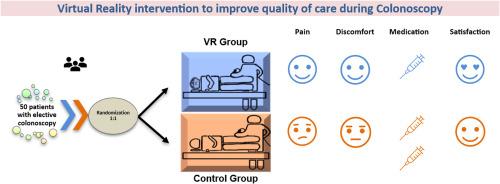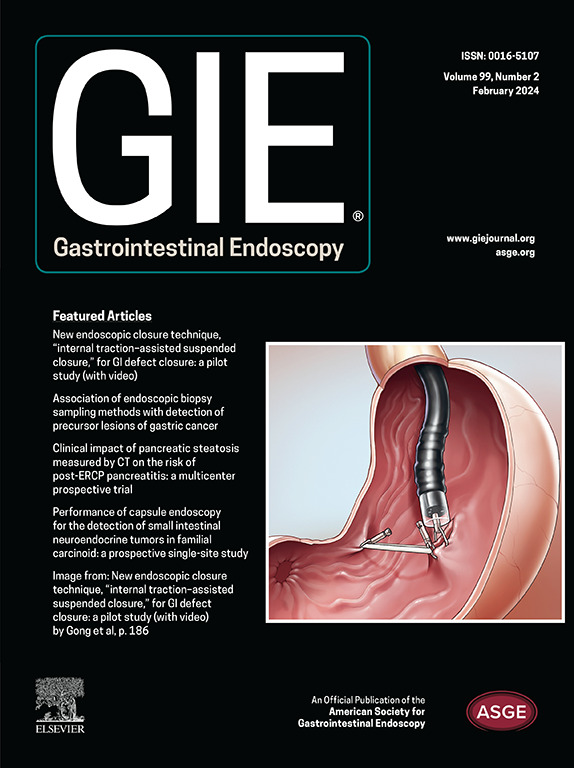Virtual reality intervention to improve quality of care during colonoscopy: a hybrid type 1 randomized controlled trial
IF 6.7
1区 医学
Q1 GASTROENTEROLOGY & HEPATOLOGY
引用次数: 0
Abstract
Background and Aims
Effective management of patients’ pain, anxiety, and discomfort during colonoscopy is crucial for successful completion of the procedure, patient adherence to follow-up examinations, and patient satisfaction. Virtual reality (VR) interventions, as a nonpharmacologic and innovative solution, have demonstrated promising results in managing these outcomes. Nevertheless, there is limited evidence on their effectiveness and implementation. This trial aimed to test clinical effectiveness and identify factors to facilitate the implementation of VR during colonoscopy.
Methods
A hybrid type 1 effectiveness implementation, parallel randomized controlled, open-label trial was conducted. Fifty patients were randomized (1:1) to a VR or a control group. The effectiveness (pain, anxiety, discomfort, medication use, and satisfaction) and implementation (reach, adoption, implementation, and maintenance) outcomes were assessed before, during, and after colonoscopy.
Results
Patients in the VR group reported significantly lower pain (P = .043) and discomfort (P <.0001) during colonoscopy, had a higher number of completed colonoscopies without sedation (P = .003), and showed higher satisfaction (P = .032). The major barrier to the implementation and maintenance of the VR intervention was inadequate VR content design. Staff were most worried about altered patient communications, unclear responsibilities, increasing workload, and patient safety. Patients expressed willingness to reuse VR glasses and to suggest them to other patients.
Conclusions
VR can be used as a nonpharmacologic method for pain management and for overcoming anxiety and discomfort during colonoscopy. VR can improve patients’ satisfaction and diminish the need for sedative medications; accordingly, it has the potential to promote cooperation and compliance among patients and increase screening colonoscopy rates. (Clinical trial registration number: NCT05723861.)

虚拟现实干预提高结肠镜检查护理质量:混合 1 型随机对照试验。
背景和目的:有效控制结肠镜检查过程中患者的疼痛、焦虑和不适感对于顺利完成手术、患者坚持随访检查以及患者满意度至关重要。虚拟现实(VR)干预作为一种非药物性的创新解决方案,在控制这些结果方面取得了可喜的成果。然而,有关其有效性和实施情况的证据还很有限。本试验旨在测试结肠镜检查的临床有效性,并确定促进结肠镜检查期间实施 VR 的因素:方法:进行了一项有效性-实施性混合型、平行随机对照、开放标签试验。50 名患者被随机(1:1)分配到 VR 组或对照组。在结肠镜检查前、检查过程中和检查后,对有效性(疼痛、焦虑、不适、药物使用和满意度)和实施性(接触、采用、实施和维持)结果进行了评估:结果:VR 组患者的疼痛感(P=0.043)和不适感(P=0.043)明显降低:结肠镜检查期间,VR 可作为一种非药物方法用于疼痛控制和克服焦虑与不适。VR 可以提高患者的满意度,减少对镇静药物的需求;因此,它有可能促进患者的合作和依从性,提高结肠镜筛查率。
本文章由计算机程序翻译,如有差异,请以英文原文为准。
求助全文
约1分钟内获得全文
求助全文
来源期刊

Gastrointestinal endoscopy
医学-胃肠肝病学
CiteScore
10.30
自引率
7.80%
发文量
1441
审稿时长
38 days
期刊介绍:
Gastrointestinal Endoscopy is a journal publishing original, peer-reviewed articles on endoscopic procedures for studying, diagnosing, and treating digestive diseases. It covers outcomes research, prospective studies, and controlled trials of new endoscopic instruments and treatment methods. The online features include full-text articles, video and audio clips, and MEDLINE links. The journal serves as an international forum for the latest developments in the specialty, offering challenging reports from authorities worldwide. It also publishes abstracts of significant articles from other clinical publications, accompanied by expert commentaries.
 求助内容:
求助内容: 应助结果提醒方式:
应助结果提醒方式:


